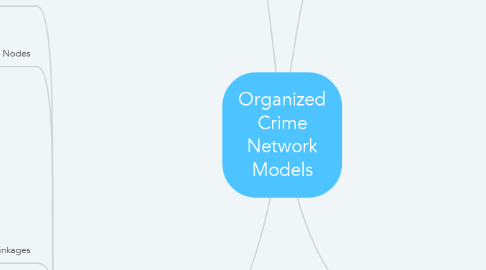
1. Broker Network
1.1. Examples
1.1.1. Gaunxi Network (Southeast Asian Heroin market)
1.1.2. Illegal arms market
1.2. Nodes
1.2.1. Brokers/ middlemen (key role)
1.2.2. Suppliers
1.2.3. Producers
1.2.4. Political protection
1.3. Linkages
1.3.1. Importance of reputation
1.4. Strengths
1.4.1. Brokers are relatively stable
1.5. Weaknesses
1.5.1. Less continuity
1.6. Attack strategy
1.6.1. Knowledge acquisition
1.6.2. Remove/ exploit brokers
1.6.3. Discrediting tacts
1.6.4. Make market less profitable/ more risky
2. Flux Network
2.1. Examples
2.1.1. Dutch Model (Vann Traa Report, 1966)
2.2. Nodes
2.2.1. Independent small groups/ individuals (decentralized)
2.3. Linkages
2.3.1. Constantly pulsating/ shifting
2.3.2. Limited trust
2.4. Strengths
2.4.1. Difficult to infiltrate
2.4.2. Low barriers to entry
2.4.3. Limited corruption linkages
2.5. Weaknesses
2.5.1. Difficult for enterprises to grow
2.6. Attack strategies
2.6.1. Change incentive structures and environment
2.6.2. Increase entry barriers
3. Core Network
3.1. Examples
3.1.1. Cali Cartel (Williams, 2001)
3.2. Nodes
3.2.1. Core group
3.2.1.1. Organizing/ steering mechanism
3.2.1.2. Relatively small (20 or less people)
3.2.2. Specialized critical nodes
3.3. Linkages
3.3.1. Linkages within the Core
3.3.1.1. Strong collective identities
3.3.1.2. Tight Coupling
3.3.1.3. Hierarchical, vertical relationships
3.3.1.4. Bonding mechanisms to create high degrees of trust and cohesion
3.3.1.4.1. Family or Kinship
3.3.1.4.2. Ethnicity
3.3.1.4.3. Common experience
3.3.1.4.4. Membership in youth gangs
3.3.2. Linkages at the Periphery
3.3.2.1. Less dense patterns of interactions
3.3.2.2. Looser relationships
3.4. Strengths
3.4.1. Central direction and control
3.4.2. Larger
3.4.3. Network periphery facilitates information gathering and mobilization of resources from external environment
3.5. Weaknesses
3.5.1. Vulnerable to decapitation (Kingpin Strategy)
3.5.2. Capacity for corruption / co-option
3.6. Attack strategy
3.6.1. Decapitation
3.6.2. Removal of critical nodes
3.6.3. Attack criminal political linkages
3.6.4. Beware unintended consequences
4. Mesh Network
4.1. Examples
4.1.1. Colombian Drug Trade (Kenney, 2007)
4.2. Nodes
4.2.1. Independent small groups/ individuals (decentralized)
4.2.2. Group specialization in specific tasks
4.3. Linkages
4.3.1. Loose Coupling
4.3.2. Multiple / alternative pathways using different groups
4.3.3. Horizontal accountability between groups
4.3.4. Associational linkages
4.3.4.1. Family and friendship ties
4.3.4.2. Social connections
4.3.4.3. Economic interdependencies
4.3.4.4. Patronage relations
4.3.4.5. Opportunity partnerships
4.3.4.6. Repeated exchanges
4.4. Strengths
4.4.1. Shared risk
4.4.2. Resilient and flexible
4.5. Weaknesses
4.5.1. Key linkages are vulnerable to corruption/ disruption
4.6. Attack strategies
4.6.1. Determine critical nodes / processes
4.6.2. Selective disruptive attacks where nodal and process criticality come togeter
